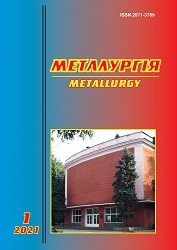INVESTIGATION OF THE STRUCTURE OF PHTHALIMIDE-MODIFIED EPOXY MATRIX BY IR-SPECTRAL ANALYSIS
Abstract
Epoxy diane oligomer ED-20 was used as the main component for the for-mation of polymeric materials. It is characterized by a set of properties, namely: high adhesive strength, the possibility of curing at low temperatures, low shrink-age, manufacturability when applied to long-dimensional parts of a complex profile, the presence of a significant number of analogues, including in Ukraine. Pol-yethylene polyamine (PEPA) hardener was used to crosslink the epoxy oligomer at room temperature. Improving the properties of the epoxy matrix was achieved by using a modifier of phthalimide (isoindoline-1,3-dione) at a content of q = 0.25 pts.wt. at q = 100 pts.wt. of epoxy oligomer ED-20. The combination of components in the formation of polymeric materials was performed using ultrasonic dispersion. The operating frequency range was ν = 20…25 kHz, ultrasonic power N = 400… 1200 W. The amplitude of oscillations of the dispersant was A = 10… 20 μm, and the operating range was d = 20 mm. Under these parameters, ultrasonic treatment was performed for a time τ = 1.5±0.1 min, followed by cooling the composition to room temperature and the introduction of a hardener. The activity of the surface of the modifier was investigated by IR-spectral analysis. The main parameters of the IR spectra were determined using the computer program IRsolution. By the method of IR spectral analysis the presence of active groups: -NH-, O-H, С-H, C-N in the range of wave numbers ν = 3202…1971 cm–1, carbonyl C = O – at ν = 1759 cm–1, amide – in the range wave numbers of ν = 1604…1467 cm–1, amino groups – in the range of wave numbers ν = 648…794 cm–1, which indicates the catalytic activity of the modifier were found. Additionally, the dynamics of changes in the transmittance intensity, the relative area of the bands of the original and modified matrices were analyzed, which allowed to confirm the preliminary results of the study of the cohesive strength of polymers by increasing the number of chemical bonds in the volume of the polymer.
References
2. Kashytskyi V., Savchuk P., Malets V., Herasymiuk Y., Shchehlov S. Examining the effect of physical fields on the adhesive strength of protective epoxy composite coatings Eastern-European Journal of Enterprise Technologies. 2017. No. 3/12(87). S. 16–22.
3. Stukhlyak P.D., Moroz K.M. Influence of porosity in the epoxy matrix-polyvinyl alcoholdisperse filler system on the impact toughness. Materials Science. 2011. Vol. 46, No 11. Р. 455–463.
4. Stukhlyak P., Holotenko O., Dobrotvor I., Mytnyk M. Investigation of the adhesive strength and residual stresses in epoxy composites modified by microwave electromagnetic treatment. Materials Science. 2015. Vol. 51. No. 2. S. 208–212.
5. Букетов А.В., Негруца Р.Ю., Яцюк В.М. Вплив модифікатора 2,4-диаміноазобензол-4'карбонової кислоти на адгезійні властивості та залишкові напруження захисних полімерних покриттів. Наукові нотатки. Луцьк : ЛНТУ. 2019. Вип. 65. С. 30–38.
6. Букетов А.В., Сметанкин С.А. Влияние модификатора 4, 4-сульфонилбис (4,1-фелен) бис(N,N-диэтилдитиокарбамата) на адгезионные свойства эпоксидной матрицы. Механика композиционных материалов и конструкцій. 2018. T. 24. № 2. С. 242–265.
7. Букетов А.В. Браило Н.В., Сапронов О.О., Яцюк В.Н., Акимов А.В. Исследование влияния модификатора 2-метил-2-тиоцианато-3-(4-тиоцианатофенил)пропиоамида на структуру и свойства эпоксидной матрицы. Механика композиционных материалов и конструкцій. 2014. № 4(20). С. 539–554.
8. Букетов А.В., Сапронов А.А., Яцюк В.Н., Грищук Б.Д., Барановський В.С. Исследование влияния 1,4-бис(N,N диметилдитиокарбамато)бензена на механические свойства эпоксидной матрицы. Пластические массы. 2014. № 3–4. С. 26–34.
9. Ходаковський О.В., Амелін М.Ю., Букетова Н.М., Сапронов О.О., Яцюк В.М. Дослідження фізико-механічних властивостей модифікованих парааміноазобензолом епоксидних композитів для ремонту засобів транспорту. Науковий вісник ХДМА. 2017. № 1(16). С. 113–120.
10. Ходаковський О.В., Амелін М.Ю., Букетова Н.М., Яцюк В.М. Теплофізичні властивості модифікованих парааміноазобензолом епоксидних матриць для захисних покриттів деталей транспортної галузі. Науковий вісник ХДМА. 2017. № 1(16). С. 216–225.
11. Накамото К. ИК-спектры и спектры КР неорганических и координационных соединений. Москва : Мир, 1991. 536 с.
12. Наканиси К. Инфракрасные спектры и строение органических соединений. Москва : Мир, 1965. 216 с.
13. Рабек Я.Р. Экспериментальные методы в химии полимеров: пер. с англ. Москва : Мир, 1983. Ч. 1. 384 с.
14. Казацына Л.А., Куплетская Н.Б. Применение УФ-, ИК- и ЯМР-спектропии в органической химии: Учеб. пособие для вузов. Москва : Высшая школа, 1971. 264 с.

 ISSN
ISSN 


